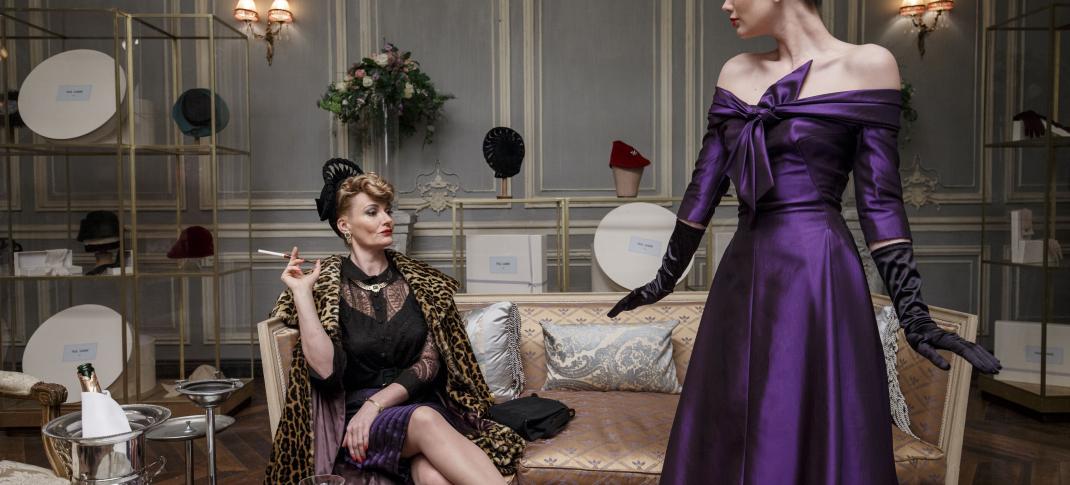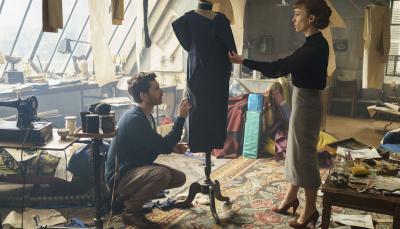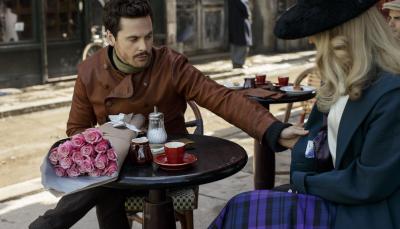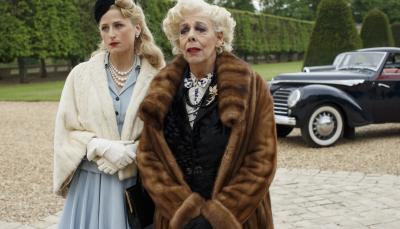'The Collection' Episode 1: Bankrolled By The Cotton King

The Collection arrives at the end of WWII in Paris, as the world struggles to re-right itself and forget the trauma they just lived through.
Paul Sabine: "Fashion has the power to transform us. It's not so much who you are as who you want to be."
When the Amazon Studios/BBC collaboration The Collection debuted last year in the UK, it did so only weeks ahead of rival Netflix's own bid for a European post war period drama, The Crown. I bring this up because you probably only heard of one of those before it debuted on PBS after the latest Poldark episode on Sunday, and it wasn't the one by Amazon Studios. The Crown has since gone on to be nominated for Golden Globes (which it won) and Emmy Awards (which it did not.) Meanwhile, The Collection has taken a slower path to release on US shores, first via the Prime streaming service, and now on PBS.
From the outside, both are sumptuous creations, both vaguely based in a fictionalized history of the era, The Crown being based on the life of Queen Elizabeth II, and The Collection being based on the rise of the House of Dior, err, House of Sabine. Both have costume budgets to die for, though The Collection achieves that expensive look on a much tighter budget, the sort of thing that gives one the weekly win on Project Runway. But where The Crown was willing to take the drama slow, stately and understated, The Collection turns everything up to 11.

Within the first twenty minutes of our opening episode, we've already gotten a good idea where things are heading. Paul Sabine (Richard Coyle) is the face of the Fashion House (which had just been bankrolled in an uneasy alliance with France's cotton king, in hopes that making fashionable gowns will erase the memories of recent Nazi collaborations and war crimes.) But it's his gay brother Claude (Tom Riley) who is the talent, who Paul is already trying to keep under wraps.
Add to that Nina (Jenna Thiam), the seamstress who just had a baby out of wedlock that everyone assumes belonged to the married man Paul, and the scandals are already mounting -- and that's before the reporters from Life Magazine come sniffing around.
Yvette Sabine: If I wanted to make stops, I'd take a bus. Fetch me a taxi.
Meanwhile, Claude is attacked by one of his own lovers early on in the episode, leaving Paul panicking lest he lose his hidden talent before they can finish designing the collection. No worries though, the Sabine matriarch (played by the great Frances La Tour) is going to make sure Paul keeps his brother producing and protected, as best he can, even if the idiot American Paul married is too clueless to see through Claude's uncloseted lifestyle. (The idiot American wife is no match for Yvette Sabine, don't you worry. Watching La Tour eat her for lunch, along with every other scene, is fantastic.)
Despite the conservative nature of the Sabines, this is Paris in the mid 1940s, newly freed from Vichey France, and a romantic playground for Americans, like photographer Billy Novak (Max Deacon). While Paul might have hired him in hopes of controlling the narrative, it's Nina Billy's got eyes for, as she slowly works her way from seamstress to would-be model. Nina insists she is perfectly fine as just a sewer, but Paul ignores that, one he sees Billy's prints. She must want something more. Why else would she put on the dress to begin with?

It's here that we reach one of the more historical moments of the series, though not exactly as it happened in real life. When the House of Dior revolutionized Paris fashion in 1947 with their "New Look", there were many of the older generation in Paris, those who had survived two world wars and decades of fabric rationing who went ballistic, calling Dior's work needlessly decadent. Months after the New Look show, in the Spring of 1948, when the clothes first became available in shops, a young woman was actually set upon by a mob, who ripped her outfit to shreds, screaming at her.
The series doesn't want us to wait that long, especially since the Sabine version of the New Look 1947 game changing fashion show won't be showing up for at least a couple of more episodes. So instead they have Nina go out with Billy to shoot some of the "retooled looks" for the upcoming show, in order to tease what's coming. The shock of Nina in the signature red gown against the rainy dull streets of Paris is a remarkable one, as is the terifying mob scene that follows (even if they don't dare rip her clothes down to the skivvies.) For all the show's flaws, this remarkable artistic moment on screen is worth the price of admission.
Paul: "Those people who attacked you only have memories. You still have dreams."
But let's be clear -- this show may be as beautiful to look at as the clothes are, but there are flaws all over the place. The cast is far too strong for the story to feel this facile upon viewing. The accents are a complete, and startling, mess. The Americans are klutzily Americanized, the minor characters all do vaguely French-ish accents, and the Sabines, in what is more standard for more fantasy/science fiction, all sport posh British accents.
Then there's the dialogue. Hamfisted at the best of times, like Nina's mother MaryAnne pointing out to Billy the buildings he loves for their "historical character" was paid for in lives, with "Those pock marks on the walls came from bullets." Paul's insistance "Everything I do I do for this family," and "The one thing they couldn't take is are imagination" can be downright cringeworthy. As cringeworthy as the need for the excess blood stains and needless extra drama packed in all around the edgs, like cotton wool packaging to fill out the box the dress will ship in.
All we need is the clothes, thank you kindly. But when the show remembers that's their heart, it's worth it.




